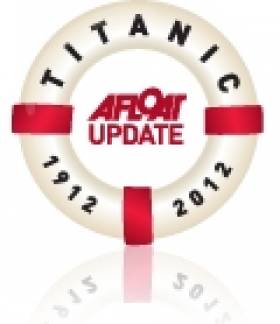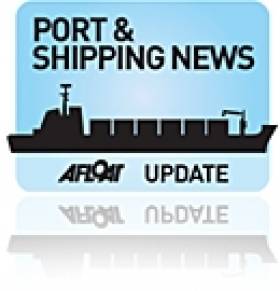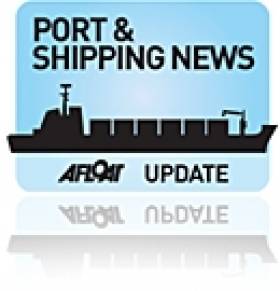Displaying items by tag: Belfast Lough
Titanic Belfast 'Is Designed to Impress'
#TITANIC - The Independent's Simon Calder reports on his special preview of Titanic Belfast, the £97 million (€116.3 million) tribute to the ill-fated ship on Belfast Lough.
"For once, the term 'of Titanic proportions' applies literally." he writes. "The top of the five-storey building is exactly as high as the tip of Titanic when the transatlantic liner was completed at the Harland and Wolff yard a century ago."
The monument is not only intended as a tribute to the tragedy, but also as a beacon to attract tourists to the "open, friendly city" of Belfast that has emerged after decades of the Troubles.
The travel writer compares the city's plans to the renaissance of Bilbao in northern Spain - like Belfast, a former shipbuilding centre damaged by terrorism that has become "a vibrant, elegant city that stands alongside Amsterdam, Barcelona and Berlin" thanks in part to the bold architecture of the Guggenheim museum.
Calder adds: "Almost every aspect of Titanic Belfast chimes with the city beyond the structure's metal jacket and big windows. And as with Titanic herself, the fitting out is designed to impress."
As previously reported on Afloat.ie, Titanic Belfast will be one of the largest employers in Northern Ireland’s tourism industry, as well as one of the North’s largest recruiters, when it opens later this month.
The Independent has much more on the story HERE.
Two Bodies Recovered from Water Near Belfast
#NEWS UPDATE - The PSNI has confirmed that the body recovered from Belfast Lough yesterday morning is that of missing Stranraer man Carius McNicoll.
According to BBC News, the 24-year-old student was last seen on a ferry shortly before docking on 8 January.
His body was discovered near Holywood in Co Down. A post-mortem has confirmed that the cause of death was drowning.
In a separate incident yeserday, The Irish Times reports that a body recovered by divers in the River Lagan is believed to be that of a missing 20-year-old man.
John Murphy had reportedly entered the river at the Lagan Weir after an evening at the nearby Odyssey Arena last month. The body found has yet to be formally identified as Murphy.
In the wake of his loss, Murphy's family has called for an end to cheap drinks promotions.
Home With Views of Belfast Lough is Sure to Impress
#WATERFRONT PROPERTY - A stunning four/five-bed home with extensive views over Belfast Lough could be yours for less than €500,000.
Accommodation at 36 Loughview Village in Carrickfergus comprises a lounge with feature fireplace with a natural stone surround, as well as a dining room and sunroom.
The kitchen is fitted in a range of high and low-level cream country-style units and butcher block work surfces, and a downstairs WC.
On the first floor there are four bedrooms including master bedroom with en-suite, a family room, upstairs sunroom and white family bathroom suite.
The detatched property boasts PVC double glazing and gas-fired central heating.
Gardens to the front and back are laid in lawn with a paved pathway and patio area respectively.
The home also has the added bonus of an attached garage and tarmac parking.
Estage agents Home and Away Properties are offering this home at a bargain price of £350,000 (€417,661), and strongly recommend an early appointment to view to avoid disappointment as internal inspection will be sure to impress.
Property.ie has more details on this property HERE.
Espey Plans Belfast Olympic Fundraiser
#OLYMPIC – Ballyholme and Royal Ulster Yacht Club sailor, James Espey has been campaigning to go to the Olympics in Weymouth this summer. As part of his campaign he is hosting a Fundraising Day on Saturday 18 February at BYC. This will include a day of coaching and racing, then and an evening party. The coaching will be taken by James himself and a guest coach. Top Laser sailors will be racing – come along and pace yourself against the best Laser sailors in the Northern Ireland.
In the evening there is a great party planned – Dinner and Cocktails, an Olympic auction and entertainment with music. Come along to support 'Bapsy' and send him on his Olympic journey.
James will be competing in Germany at the Laser Worlds and this is the event he is anticipating to qualify for the Games.
Saturday, 18 February
Laser Coaching 1130-1300hrs
Lunch 1300-1400 (Soup & Rolls)
Laser Racing 1400 – 3 races
Dinner & Cocktails 1900hrs
Auction @ 2030
Tickets for the full day are £30, £15 for the evening dinner and entertainment
Titanic Belfast Bosses Want the ‘T Factor’ in Frontline Job Audtions
#TITANIC - Prospective employees at the soon-to-be-opened Titanic visitor centre in Belfast will have to show the ‘T factor’ and give a performance on aspect of the doomed ship’s story, The Irish Times reports.
It’s hoped by bosses at Titanic Belfast that the three-minute scripted ‘interpretative presentation’ - based on one of the centre’s nine galleries - will indicate those candidates with the requisite passion and communications skills for one of the 70 “frontline” jobs up for grabs.
“The audition day will give prospective employees a chance to let their true personalities shine through,” said Titanic Belfast chief executive Tim Husbands.
Titanic Belfast will be one of the largest employers in Northern Ireland’s tourism industry when it opens in March, as well as one of the North’s largest recruiters.
Among its many attractions, it will also bost the region’s largest function suite for conference, weddings and other events, as previously reported on Afloat.ie.
The Irish Times has more on the story HERE.
Ship-to-Ship Transfer of OIl Cargo Delayed Yet Again
#SHIPPING - The transfer of hazardous cargo from the stricken tanker at the entrance to Belfast Lough has been delayed yet again due to winds nearing hurricane strength.
The Belfast Telegraph reports that the Genmar Conpanion - which was redirected to Belfast after reporting a cracked hull en route from Rotterdam to New York - will remain sheltering off the Copeland Islands until the weather improves.
As previously reported on Afloat.ie, the ship-to-ship transfer of 54,000 tonnes of vacuum gas oil was originally scheduled to take place on 31 December last, but the task was pushed back as the receiving ship, BW Seine, was delayed by weather in the North Sea.
It had then been hoped to begin the transfer early yesterday with the receiving ship's arrival, but the strong storm-force winds that have increasingly battered Ireland in the last 36 hours put paid to those plans.
Ship-to-ship transfers can take place in wind speeds of up to 35 knots, but yesterday the wind speed in Belfast Lough was reported as more than double that.
Hugh Shaw, the NI Secretary of State's representative for maritime salvage and intervention, told the Belfast Telegraph: "As soon as we have a window to do the ship-to-ship transfer safely we will take it.
"Winds have been dropping a bit, but it looks unlikely the operation will take place on Wednesday."
Transfer of Cargo from Stricken Tanker Delayed
#SHIPPING - The transfer of cargo from the damaged oil tanker sheltering at the entrance to Belfast Lough has been posponed for at least two more days.
As previously reported on Afloat.ie, the 228-metre Germar Companion - which is carrying 54,000 tonnes of vacuum gas oil - was redirected to Belfast after reporting a cracked hull en route from Rotterdam to New York.
The merchant vessel has been sheltering off the Copeland Islands since 16 December, where an official examination recommended removal of the cargo.
Today (31 December 2011) had been the scheduled start date for the move of the tanker's hazardous cargo by ship-to-ship tranfer. But the move has been delayed as the second ship, the BW Seine, is still en route to Belfast Lough.
"It is currently in the North Sea and could take another two days before it reaches the vessel and starts to transfer the cargo," a coastguard spokesperson told the Belfast Telegraph.
The transfer will be managed by specialist company Fendercare Marine in the lough, and could take between 24 and 36 hours. Once finished, the Germar Companion will sail into Belfast for repairs.
Cracks in Hull Force Tanker Re-Routing to Belfast
#SHIPPING - The Irish Times reports that a tanker carrying hazardous cargo has been allowed to berth at Belfast Port after it reported a cracked hull off the north-west coast.
The 228-metre Germar Companion, which is is carrying 54,000 tonnes of vacuum gas oil, was on route from Rotterdam to New York when its crew discovered cracking in its upper deck some 25 miles off Tory Island.
The Air Corps and Naval Service were stood down after the cargo ship was granted permission to berth at Belfast, where its hull will be inspected.
Belfast Lough Regatta Dates for 2012
#BELFAST LOUGH - Provisional dates for the 2012 Belast Lough Yachting Conference (BLYC) Regattas have been announced.
The BLYC encompasses all yacht clubs on Belfast Lough and Larne Lough and co-ordinates their individual events.
The interim schedule for 2012 runs to nine events from Saturday 9 June to Saturday 25 August:
- Sat 9 June - Royal Ulster Yacht Club
- Sat 23 June - Ballyholme Yacht Club
- Sat 7 July - Holywood Yacht Club
- Sat 21 July - East Antrim Boat Club
- Sat 28 July - County Antrim Yacht Club
- Sat 4 August - Cockle Island Boat Club
- Sat 11 August - North of Ireland Yacht Club
- Sat 18 August - Donaghadee Sailing Club
- Sat 25 August - Carrickfergus Sailing Club
Historic Days on North Channel Ferry Routes
#FERRY NEWS- In the space of two days, Stena Line opened a new ferry route between Belfast-Cairnryan today following yesterday's closure of services between Belfast-Stranraer, writes Jehan Ashmore.
Sisters Stena Superfast VII and Stena Superfast VIII inaugurated sailings on the 2 hour 15 minute with 12 crossings daily, and in which will use a new £80m ferry terminal at Loch Ryan Port, Cairnryan and the VT4 terminal in Belfast. The relocation of Scottish ports and terminal investment cost £200m.
The newcomers have a capacity for 1,200 passenger /660 vehicles or 110 freight units. They received a refit and upgrade in Poland where new luxurious facilities such as a Nordic Spa, interactive lounge zone with the latest in technology and free Wi-Fi access throughout the vessel and VIP lounges were installed. To read more click HERE.
At 204m and over 30,000 tonnes each the German built pair are easily the largest ever ferries to operate in the North Channel and will compete with rivals P&O Larne-Cairnryan route served by the 20,000 tonnes sisters European Causeway and European Highlander both built in Japan.
The introduction of the former Scandinavian serving sisters directly replaced Stena Caledonia and HSS Stena Voyager from the Belfast-Stranraer route which only started in 1995. Prior to then Stena Line had operated a service from Larne, which could trace ferry services for the last 123 years.
The Swedish ferry company decided to abandon the route in favour of Belfast. This development also saw the introduction of the second revolutionary HSS 1500 series catamaran ferry HSS Stena Voyager in tandem with various conventional tonnage used over the last sixteen years. The final sailings at the weekend marked the closure of nearly 140 years of several ferry operators running between Stranraer at the end of Loch Ryan and Belfast.
With the withdrawal of HSS Stena Voyager and Stena Caledonia yesterday, she joins former fleetmate Stena Navigator in Belfast, which stood down from Stranraer service last week as previously reported, to read click HERE.







































































